Piezoelectric Ultrasonic Local Resonant Ultra-Precision Grinding for Hard–Brittle Materials
Abstract
:1. Introduction
2. Methods and Materials
2.1. Design of the Ultrasonic Grinding System
2.2. Finite Element Analysis and Testing
2.3. Experimental Equipment and Methods
3. Results
3.1. Surface Roughness and Material Removal Rate
3.2. Surface Morphology
4. Discussion
5. Conclusions
- (1)
- The system’s local resonant occurred at the grinding head with a resonant frequency of 20.768 kHz. Under 250 V of peak-to-peak excitation, the longitudinal vibration amplitude was 8.4 μm.
- (2)
- The optimal process parameters for the ultrasonic local resonant grinding of a sapphire were a processing gap of 0.2 mm, a grinding disc speed of 65 r/min, and an abrasive particle concentration of 15 wt%.
- (3)
- The local resonant system reduced the surface roughness parameter (Ra) of sapphire to 14 nm and improved the surface flatness to 44.2 nm, which showed that the designed system met the requirements for the ultrasonic ultra-precision grinding of sapphire.
- (4)
- Compared with a conventional resonant system, the surface roughness of the sapphire ground with the local resonant system was reduced by 90.79%, the surface flatness was improved by 81.58%, and the material removal rate was increased by 31.35%.
Author Contributions
Funding
Data Availability Statement
Conflicts of Interest
References
- Han, G.; Zhao, J.; Wang, X. Research on unbounded abrasive polishing process with assisted ultrasonic vibration of workpiece. Int. J. Adv. Manuf. Technol. 2017, 88, 209–218. [Google Scholar] [CrossRef]
- Zhang, Y.; Zhang, Q.; Zhao, J.; Zhu, Y.; Fu, X.; Yang, C.; Chen, Y. Ultrasonic vibration assisted milling of titanium alloy microchannel. Precis. Eng. 2024, 88, 251–265. [Google Scholar] [CrossRef]
- Huang, W.; Zhong, Q.; An, D.; Yang, C.; Zhang, Y. Mechanism and Experiment Study of Non-Contact Ultrasonic Assisted Grinding. Actuators 2021, 10, 238. [Google Scholar] [CrossRef]
- Sun, G.; Shi, F.; Zhao, Q.; Ma, Z.; Yang, D. Material removal behaviour in axial ultrasonic assisted scratching of zerodur and ule with a vickers indenter. Ceram. Int. 2020, 46, 14613–14624. [Google Scholar] [CrossRef]
- Dambatta, Y.S.; Li, C.; Sayuti, M.; Sarhan, A.; Yang, M.; Li, B.; Zhou, Z. Grindability Evaluation of Ultrasonic Assisted Grinding of Silicon Nitride Ceramic Using Minimum Quantity Lubrication Based SiO2 Nanofluid. Chin. J. Mech. Eng. 2024, 37, 25. [Google Scholar] [CrossRef]
- Wang, H.; Pei, Z.; Cong, W. A feeding-directional cutting force model for end surface grinding of CFRP composites using rotary ultrasonic machining with elliptical ultrasonic vibration. Int. J. Mach. Tools Manuf. 2020, 152, 103540. [Google Scholar] [CrossRef]
- Chen, F.; Mei, G.; Zhao, B.; Bie, W.; Li, G. Study on the characteristics of zirconia ceramic in three-dimensional ultrasonic vibration-assisted ELID internal grinding. J. Mech. Sci. Technol. 2020, 34, 333–344. [Google Scholar] [CrossRef]
- Zhou, F.; Xu, J.; Zhang, W.; Yu, H. Study of the inhibition mechanism of sapphire subsurface damage by tangential ultrasonic vibration. Mech. Adv. Mater. Struct. 2024, 36, 1–26. [Google Scholar] [CrossRef]
- Zhou, M.; Zhong, M.; Xu, W. Novel model of material removal rate on ultrasonic-assisted chemical mechanical polishing for sapphire. Friction 2023, 11, 2073–2090. [Google Scholar] [CrossRef]
- Xie, W.; Zhang, Z.; Liao, L.; Liu, J.; Su, H.; Wang, S.; Guo, D. Green chemical mechanical polishing of sapphire wafers using a novel slurry. Nanoscale 2020, 12, 22518–22526. [Google Scholar] [CrossRef]
- Yun, J.-C.; Wang, B.-Y.; Lee, E.-S.; Lee, C.-H.; Lim, Y.-K.; Lim, D.-S.; Cho, H.-G. Effect of the properties of uniformly patterned micro-diamond pellets on sapphire grinding. J. Korean Phys. Soc. 2020, 73, 871–876. [Google Scholar] [CrossRef]
- Lee, S.; Kim, J.; Oh, C.-H.; Shim, J.-I.; Park, Y.; Yoon, E. Fabrication of less bowed light-emitting diodes on sapphire substrates with a SiO2 thin film on their back sides. J. Korean Phys. Soc. 2019, 75, 480–484. [Google Scholar] [CrossRef]
- Yi, J. Sapphire fabry–perot pressure sensor at high temperature. IEEE Sens. J. 2020, 21, 1596–1602. [Google Scholar] [CrossRef]
- Zhang, Y.; Zhu, D.; Xuan, W.; Jin, H.; Dong, S.; Luo, J. Single-crystalline AIN/sapphire and composite electrode based ultra-high temperature surface acoustic wave devices. J. Phys. D Appl. Phys. 2023, 56, 16LT01. [Google Scholar]
- Li, Z.; Deng, Z.; Ge, J.; Liu, T.; Wan, L. Experimental and theoretical analysis of single-sided and double-sided chemical mechanical polishing of sapphire wafers. Int. J. Adv. Manuf. Technol. 2022, 119, 5095–5106. [Google Scholar] [CrossRef]
- Liu, H.-K.; Chen, C.-C.A.; Chen, W.-C. Effects of compound diamond slurry with graphene for lapping of sapphire wafers. Int. J. Adv. Manuf. Technol. 2020, 106, 4755–4768. [Google Scholar] [CrossRef]
- Xie, Z.; Li, J.; Tian, Y.; Du, P.; Zhao, B.; Xu, F. Theoretical and experimental study on influences of surface texture on lubrication performance of a novel bearing. Tribol. Int. 2024, 193, 109351. [Google Scholar] [CrossRef]
- Yang, X.; Yang, X.; Gu, H.; Kawai, K.; Arima, K.; Yamamura, K. Efficient and slurryless ultrasonic vibration assisted electrochemical mechanical polishing for 4H–SiC wafers. Ceram. Int. 2022, 48, 7570–7583. [Google Scholar] [CrossRef]
- Chen, Y.; Su, H.; He, J.; Qian, N.; Gu, J.; Xu, J.; Ding, K. The effect of torsional vibration in longitudinal–torsional coupled ultrasonic vibration-assisted grinding of silicon carbide ceramics. Materials 2021, 14, 688. [Google Scholar] [CrossRef]
- Li, Y.; Zhang, D.; Wang, H.; Ye, G.; He, R.; Cong, W. Theoretical and experimental investigations on rotary ultrasonic surface micro-machining of brittle materials. Ceram. Int. 2020, 46, 14613–14624. [Google Scholar] [CrossRef]
- Liu, Z.; Jin, X.; Zhang, J.; Hao, Z.; Li, J. Design optimization and eigenfrequency tuning of ultrasonic oscillator of one-dimensional longitudinal vibration at high temperature for laser welding. Int. J. Adv. Manuf. Technol. 2022, 119, 4011–4029. [Google Scholar] [CrossRef]
- Cristea, B.; Ghiculescu, L.; Titu, A.; Deopale, C. Modeling and Simulation of an Ultrasonic Concentrator Used in a Feed System for Ultrasonically Aided MICROEDM. Acta Tech. Napoc. Ser. 2024, 67, 1. [Google Scholar]
- Zhu, X.; Xu, K.; Zhao, B.; Ma, D. Experimental and theoretical research on local resonance in an ultrasonic honing system. J. Mater. Process. Technol. 2002, 129, 1–3. [Google Scholar] [CrossRef]
- Zhao, B.; Bie, W.; Wang, X.; Chen, F.; Wang, Y.; Chang, B. The effects of thermo-mechanical load on the vibrational characteristics of ultrasonic vibration system. Ultrasonics 2019, 98, 7–14. [Google Scholar] [CrossRef]
- Wang, T.; Sheng, M.; Ding, X.; Yan, X. Wave propagation and power flow in an acoustic metamaterial plate with lateral local resonance attachment. J. Phys. D Appl. Phys. 2018, 51, 115306. [Google Scholar] [CrossRef]
- Xie, Z.; Jiao, J.; Zhao, B.; Zhang, J.; Xu, F. Theoretical and experimental research on the effect of bi-directional misalignment on the static and dynamic characteristics of a novel bearing. Mech. Syst. Signal Process. 2024, 208, 111041. [Google Scholar] [CrossRef]
- Maurotto, A.; Wickramarachchi, C.-T. Experimental investigations on effects of frequency in ultrasonically-assisted end-milling of AISI 316L: A feasibility study. Ultrasonics 2016, 65, 113–120. [Google Scholar] [CrossRef]
- Gao, Y.; Zhong, Q.; Chen, M.; Wu, Z.; Yao, L.; Tong, Z.; Zhang, S.; Gu, Y.; Lou, L. A miniaturized transit-time ultrasonic flowmeter based on ScAlN piezoelectric micromachined ultrasonic transducers for small-diameter applications. Microsyst. Nanoeng. 2023, 9, 49. [Google Scholar] [CrossRef]
- Ying, J.; Yin, Z.; Zhang, P.; Zhou, P.; Zhang, K.; Liu, Z. An experimental study of the surface roughness of SiCp/AI with ultrasonic vibration-assisted grinding. Metals 2022, 12, 1730. [Google Scholar] [CrossRef]
- Zhao, Y.; Zhang, B.; Xiao, Y.; Ye, L.; Haoran, L. Ceria-based abrasive composite to improve MRR of SiO2 in 3D-NAND. ECS J. Solid State Sci. Technol. 2021, 10, 093005. [Google Scholar]
- Guo, Z.; Luo, X.; Hu, X.; Jin, T. Investigation of Material Removal Distributions and Surface Morphology Evolution in Non-Contact Ultrasonic Abrasive Machining (NUAM) of BK7 Optical Glasses. Micromachines 2022, 13, 2188. [Google Scholar] [CrossRef] [PubMed]
- Ye, L.; Baoguo, Z.; Haoran, Z.-L.; Pengfei, W.; Ye, W.; Mengchen, X. Effect of alkali metal ion on chemical mechanical polishing of LiTaO3. ECS J. Solid State Sci. Technol. 2022, 11, 034003. [Google Scholar] [CrossRef]
- Schwarz, S.; Rung, S.; Esen, C.; Hellmann, R. All laser-based fabrication of optical elements. Front. Ultrafast Opt. Biomed. Sci. Ind. Appl. 2020, 11270, 114–122. [Google Scholar]
- Wang, S.; Zhao, Q.; Yang, X. Surface and subsurface microscopic characteristics in sapphire ultra-precision grinding. Tribol. Int. 2022, 174, 107710. [Google Scholar] [CrossRef]
- Wang, M.; Zhang, R.; Shang, Y.; Zheng, J.; Wang, X.; Xu, X. Micro-milling microstructures in air-shielding ultrasonic assisted electrochemical machining. J. Manuf. Process. 2023, 97, 171–184. [Google Scholar] [CrossRef]
- Egashira, K.; Honda, R.; Yamaguchi, K.; Ota, M. Ultrasonic-Assisted Grinding of Microholes Using Ultrasmall-Diameter Cemented WC Tools. Int. J. Autom. Technol. 2024, 18, 161–168. [Google Scholar] [CrossRef]

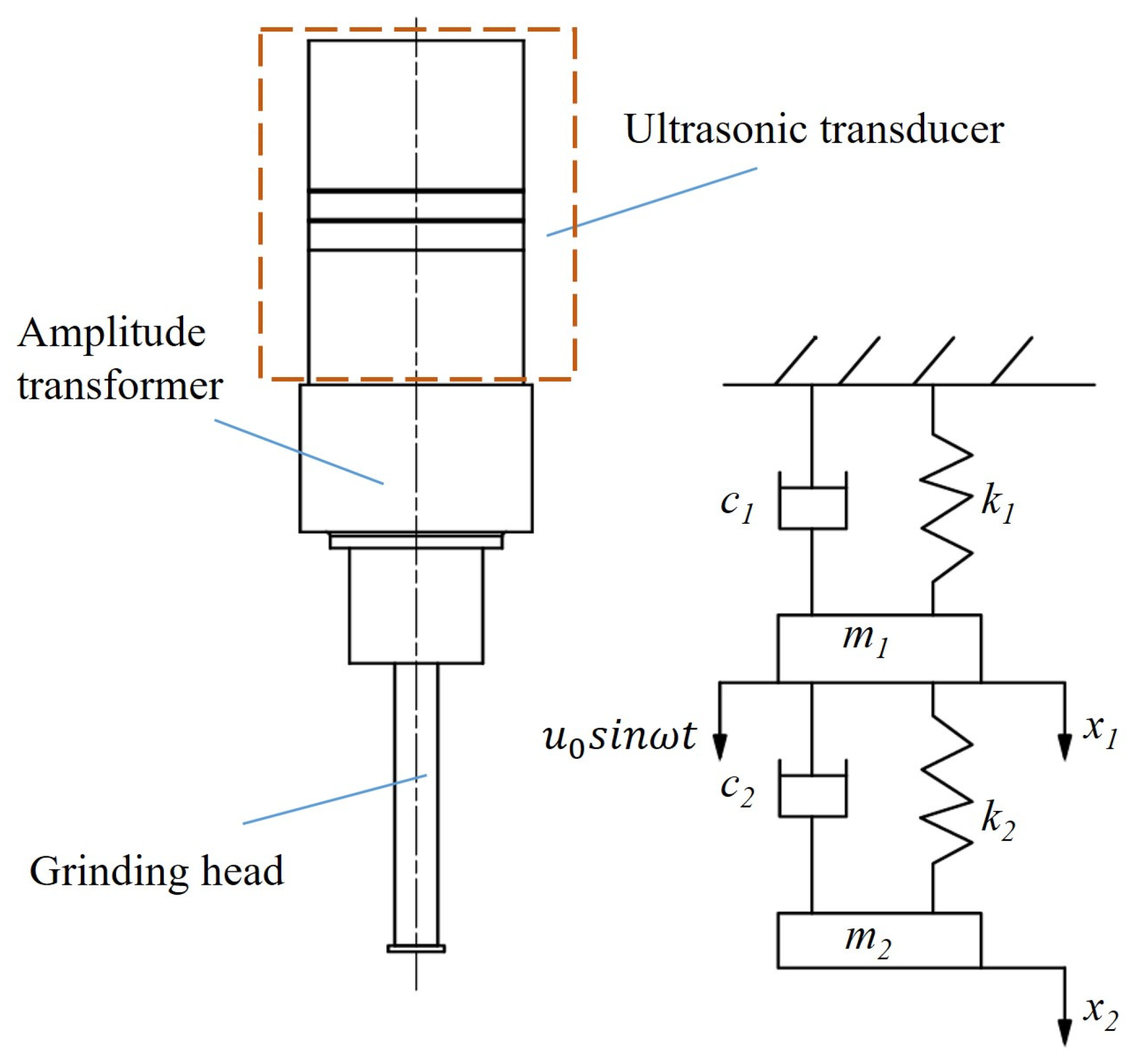
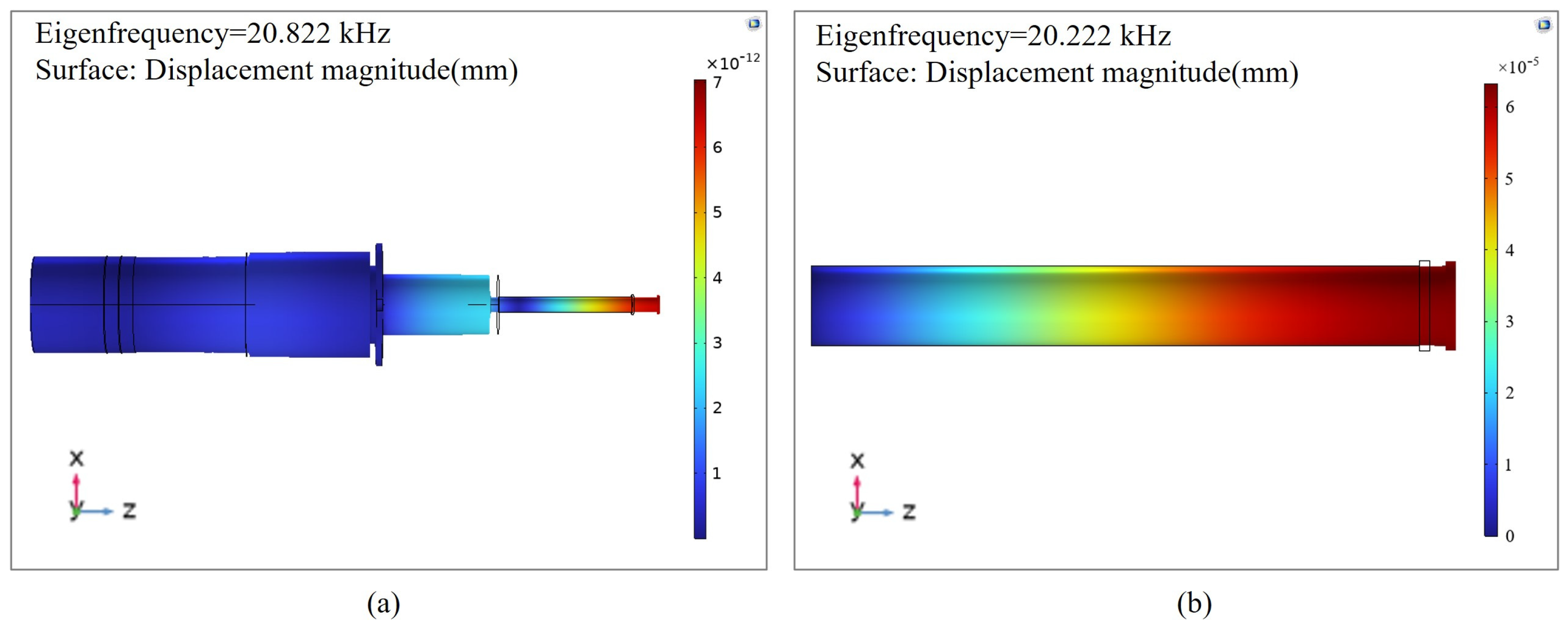
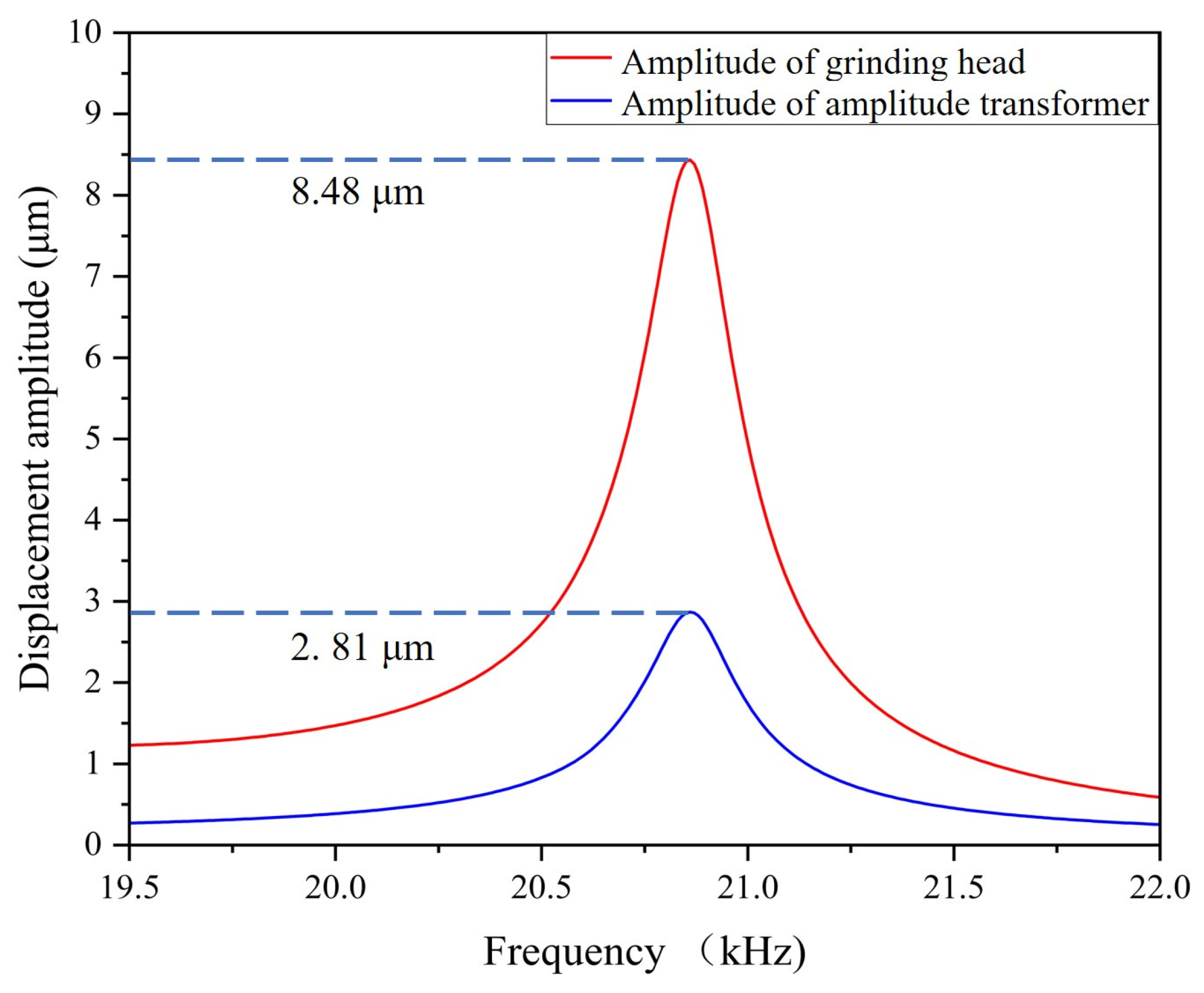

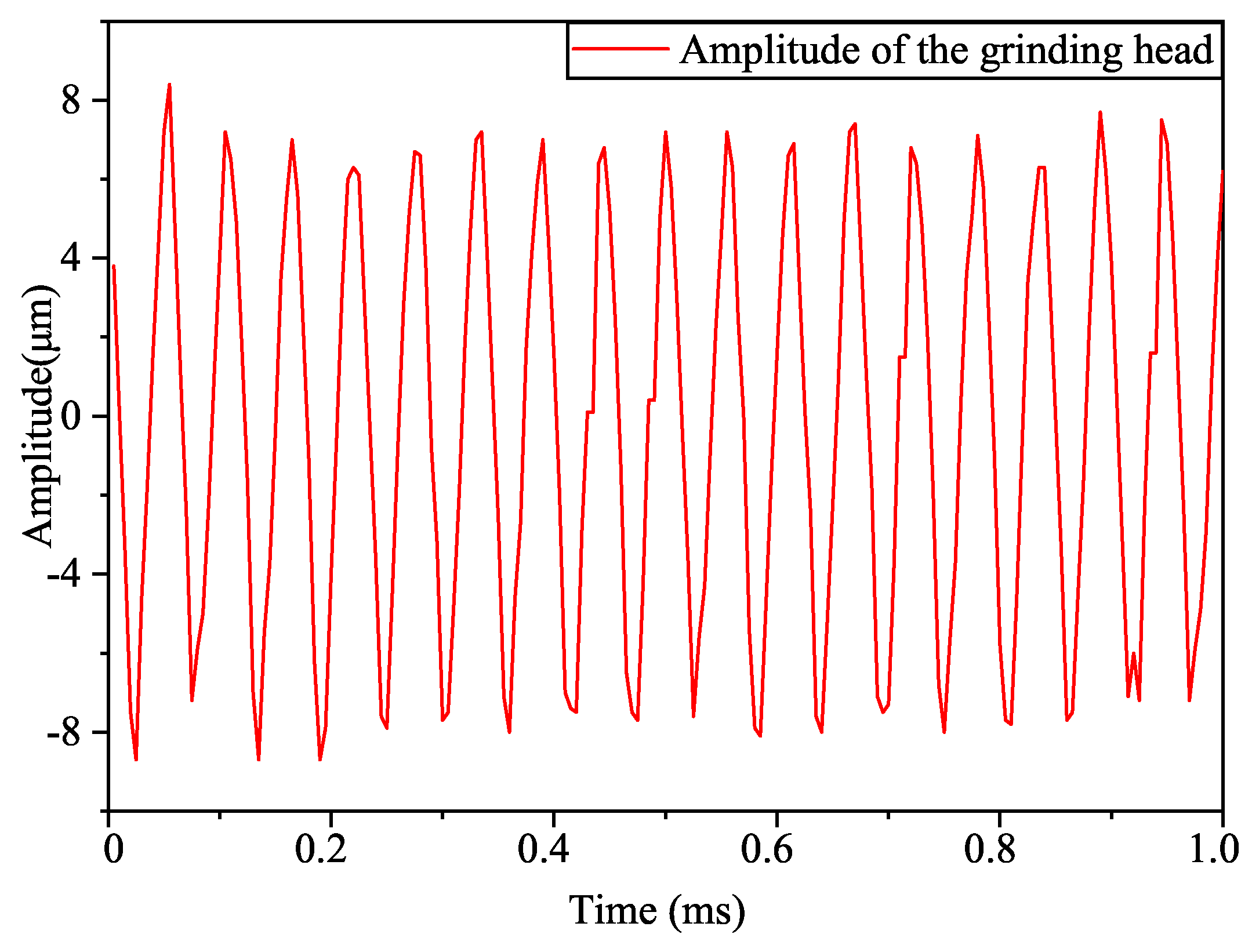


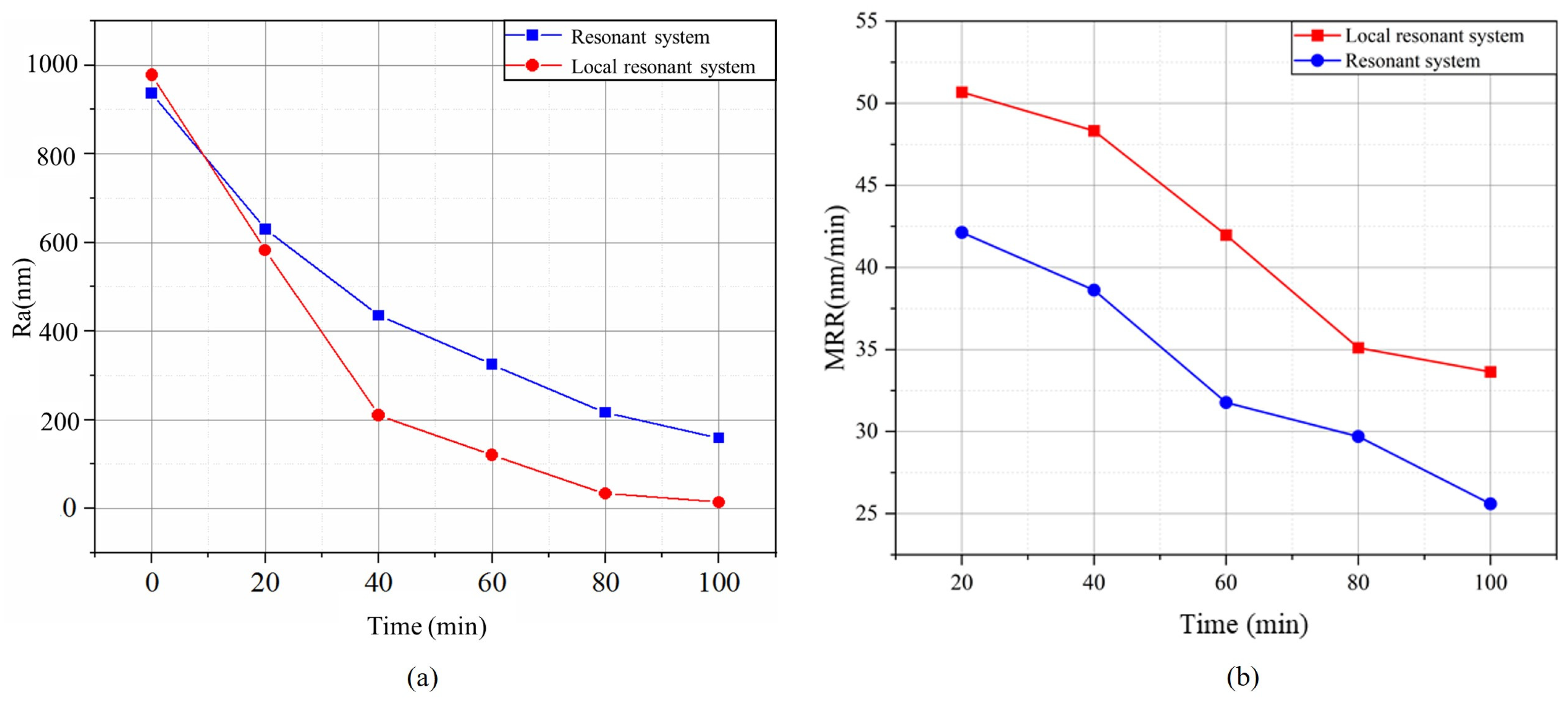


| Density | Velocity of Sound | Elastic Modulus | Poisson’s Ratio |
|---|---|---|---|
| 7930 (kg/m3) | 4941 (m/s) | 200 (GPa) | 0.3 |
| Density | Mohs Hardness | Poisson’s Ratio | Melting Point | Young’s Modulus |
|---|---|---|---|---|
| 3.98 (g/cm³) | 9 | 0.27–0.29 | 2040–2050 (°C) | 345 (GPa) |
| Frequency | Voltage | Processing Gap | Rotational Speed | Abrasive Particle Concentration |
|---|---|---|---|---|
| 20.768 (kHz) | 250 | 0.2 (mm) | 65 (r/min) | 15 (wt%) |
Disclaimer/Publisher’s Note: The statements, opinions and data contained in all publications are solely those of the individual author(s) and contributor(s) and not of MDPI and/or the editor(s). MDPI and/or the editor(s) disclaim responsibility for any injury to people or property resulting from any ideas, methods, instructions or products referred to in the content. |
© 2024 by the authors. Licensee MDPI, Basel, Switzerland. This article is an open access article distributed under the terms and conditions of the Creative Commons Attribution (CC BY) license (https://creativecommons.org/licenses/by/4.0/).
Share and Cite
An, D.; Xian, J.; Zhang, Y.; Cheng, G.; Huang, Y.; Liang, Z.; Huang, W. Piezoelectric Ultrasonic Local Resonant Ultra-Precision Grinding for Hard–Brittle Materials. Micromachines 2024, 15, 1216. https://doi.org/10.3390/mi15101216
An D, Xian J, Zhang Y, Cheng G, Huang Y, Liang Z, Huang W. Piezoelectric Ultrasonic Local Resonant Ultra-Precision Grinding for Hard–Brittle Materials. Micromachines. 2024; 15(10):1216. https://doi.org/10.3390/mi15101216
Chicago/Turabian StyleAn, Dawei, Jianghui Xian, Yi Zhang, Guoqiang Cheng, Yankai Huang, Zhongwei Liang, and Weiqing Huang. 2024. "Piezoelectric Ultrasonic Local Resonant Ultra-Precision Grinding for Hard–Brittle Materials" Micromachines 15, no. 10: 1216. https://doi.org/10.3390/mi15101216










